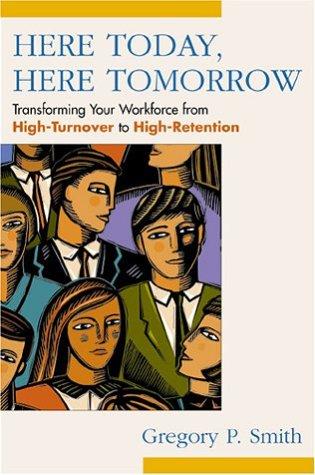Gregory P. Smith’s Here Today, Here Tomorrow, published in 2022, isn’t just another business strategy book; it’s a powerful exploration into creating truly sustainable and resilient organizations. Smith, a seasoned consultant with years of experience working with major corporations, brings a pragmatic yet deeply human perspective to the challenges of modern business. This book, emerging at a time of increasing uncertainty and rapid change, feels incredibly relevant. It speaks directly to the need for businesses to move beyond short-term gains and embrace a future-focused, values-driven approach.
Smith’s core argument revolves around the idea that long-term success is not just about profitability but also about creating a positive impact on all stakeholders, including employees, customers, and the environment. He meticulously outlines the traditional pitfalls of short-term thinking, often driven by quarterly earnings and shareholder pressures, demonstrating how these practices undermine sustainability. The book is structured in a way that builds logically from the problems we currently face to actionable solutions that organizations can adopt. The target audience appears to be business leaders and managers, but the principles apply to anyone who cares about the future of organizations.
Central to Smith’s approach is the concept of “Future-Proofing,” which he breaks down into several key components. These include fostering a culture of continuous learning and innovation, building strong and inclusive teams, and embracing transparency and accountability. Smith doesn’t just talk about these ideas in theory; he provides concrete examples and case studies from his work and others that illustrate how these strategies can be implemented successfully. For example, he showcases companies that have prioritized employee well-being and how it directly impacts productivity and retention. He also delves into how businesses can measure and reduce their environmental impact.
One of the most impactful aspects of the book is the emphasis on building a “purpose-driven” organization. Smith argues that employees are increasingly seeking meaningful work and that businesses that align their actions with a clear purpose beyond profit are more likely to attract and retain top talent. He underscores the importance of creating an authentic organizational narrative that resonates with employees and customers alike. He even discusses practical methods for defining and embedding purpose into the very DNA of a company. Click here to find this book on Amazon.
Smith’s writing style is both engaging and accessible. He avoids overly technical jargon, making the concepts easy to understand for a wide range of readers. The tone is conversational, as if Smith is sharing his insights and experiences directly with you. His use of real-world examples and anecdotes is particularly effective. They help to make the book’s ideas more relatable and demonstrate that the principles he advocates are not just abstract concepts but practical tools that can be used to build better businesses. I was particularly struck by his example of a mid-sized manufacturing company that transformed its operations after adopting a stakeholder-centric approach. This example showed me the real power of putting people first.
The book’s strength lies in its ability to blend theory with practice. Smith isn’t just presenting an idealistic view of business; he provides a framework for real change that is grounded in solid research and years of hands-on experience. He carefully presents data and evidence to support his arguments, never losing sight of the human element that drives organizational success. He makes a compelling case for why businesses must rethink their approach to leadership, strategy, and sustainability. He advocates for a shift away from the traditional shareholder-centric model towards a more balanced, stakeholder-centric approach that benefits everyone involved.
Another significant contribution of the book is its focus on the importance of ethical leadership. Smith argues that leaders must embody the values and principles they want their organization to adopt. He discusses how authenticity, transparency, and accountability are critical for building trust and fostering a culture of integrity. He doesn’t shy away from addressing difficult topics, like the ethical dilemmas faced by leaders in a rapidly changing world. He provides practical advice on how to navigate these challenges with courage and conviction. Check it out on Amazon!
The narrative flow of Here Today, Here Tomorrow is seamless, moving between theoretical concepts and practical applications without ever feeling disjointed. Smith’s voice is authoritative yet empathetic, making the reader feel both informed and inspired. He provides a clear roadmap for businesses that want to create long-term value, emphasizing that sustainability and resilience are not just buzzwords but essential components of a successful business strategy. He reminds readers that creating a better world is not only the right thing to do, but also the best thing for the bottom line.
The actionable takeaways from this book are numerous and varied. They range from establishing a clear company purpose to investing in employee development and reducing environmental impact. Smith provides detailed checklists and frameworks that organizations can use to implement these changes, ensuring that the book is not just informative but also practical. For example, he offers a step-by-step guide for developing a stakeholder engagement strategy, making the process feel less overwhelming and more manageable. The book is also useful for those seeking to implement more ethical and sustainable business practices at any level, and to understand the importance of a long-term vision.
In conclusion, Here Today, Here Tomorrow is more than just a business book; it’s a call to action. Smith convincingly demonstrates that creating sustainable and resilient organizations is not just a matter of good business but also a moral imperative. This book is a must-read for anyone who cares about the future of business and the planet. It’s an insightful, practical guide that offers a clear path towards building organizations that are not just profitable but also purpose-driven and impactful. Find it on Amazon here. Readers who enjoy this book may also appreciate titles like Conscious Capitalism by John Mackey and Raj Sisodia, and Reinventing Organizations by Frederic Laloux, which similarly explore the themes of purpose-driven business and organizational transformation. Get your copy now!

